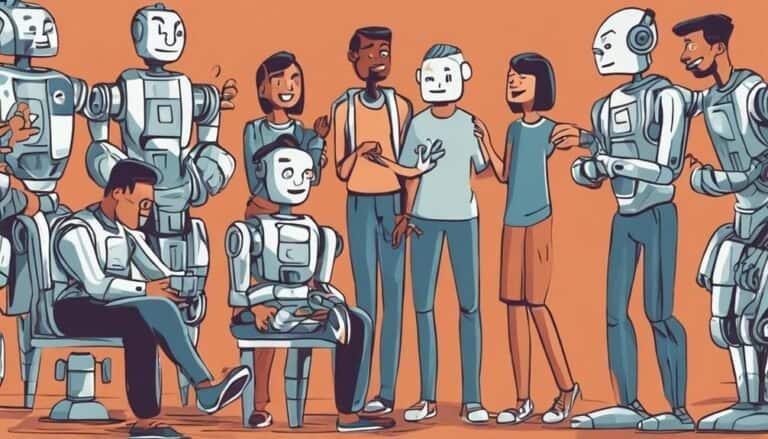AI in Language Translation: A Practical Guide
Have you ever wondered how artificial intelligence is revolutionizing the way we communicate across languages?
Dive into the intricate world of AI language translation, where neural networks play a pivotal role in bridging linguistic gaps.
Discover the practical advantages, challenges, and industry-specific solutions that AI offers in the realm of translation.
Unravel the complexities of training AI to grasp dialects and slangs, all while exploring the exciting future trends shaping the landscape of translation technology.
Key Takeaways
- Neural networks enhance translation speed and accuracy.
- AI algorithms analyze context for precise translations.
- Cultural nuances and idiomatic expressions enrich translation quality.
- Data quality enhancement boosts AI translation accuracy.
Evolution of Language Translation Tools
Through continuous advancements in technology, language translation tools have evolved significantly over the years, enhancing communication across diverse linguistic barriers. The evolutionary advancements in language translation tools have been primarily driven by groundbreaking technological breakthroughs that have revolutionized the way we approach multilingual communication.
One of the key technological breakthroughs that have propelled the evolution of language translation tools is the development of statistical machine translation (SMT). SMT systems work by analyzing large amounts of bilingual text data to generate translations based on statistical patterns. This approach marked a significant shift from rule-based translation systems, allowing for more context-aware and accurate translations.
Another pivotal advancement in language translation tools has been the integration of neural machine translation (NMT) models. NMT models leverage deep learning techniques to process entire sentences or paragraphs at once, capturing complex linguistic nuances and improving translation quality. This shift towards NMT has led to more fluent and natural-sounding translations, bridging the gap between different languages more effectively.
Furthermore, the adoption of cloud-based translation services has democratized access to advanced translation capabilities, making them more widely available and cost-effective. These services leverage powerful computational resources to deliver fast and accurate translations on a global scale, empowering businesses and individuals to overcome language barriers effortlessly. The continuous evolution of language translation tools underscores the transformative potential of AI in facilitating seamless cross-cultural communication.
Role of Neural Networks in AI
The advancements in language translation tools, particularly the integration of neural machine translation models, highlight the pivotal role of neural networks in AI, revolutionizing the way translations are processed and improving overall translation quality. Neural networks play a crucial role in language translation by enhancing the efficiency of learning algorithms and optimizing neural network structures for specific translation tasks.
Here are four key aspects that underscore the significance of neural networks in AI translation:
- Parallel Processing: Neural networks enable parallel processing of data, allowing for faster translation speeds and real-time language processing capabilities.
- Deep Learning: Through neural networks, deep learning algorithms can efficiently analyze and interpret complex linguistic patterns, leading to more accurate translations.
- Neural Network Optimization: Techniques like backpropagation and gradient descent are used to optimize neural network parameters, enhancing the accuracy and fluency of translations.
- Learning Algorithms Efficiency: Neural networks improve the efficiency of learning algorithms by adapting to new language data and continuously refining translation models based on feedback loops.
Advantages of AI Translation
When it comes to AI translation, you’ll discover key advantages such as high accuracy in translations.
AI excels in swiftly translating vast amounts of text, showcasing its speed capabilities.
These two aspects, accuracy, and speed, are fundamental to the efficiency and reliability of AI translation systems.
Accuracy in Translations
Achieving high levels of accuracy in translations is a key advantage of AI translation technology. When it comes to translation quality and handling linguistic nuances, AI excels due to its advanced algorithms and machine learning capabilities.
Here are four reasons why AI translation is known for its accuracy:
- Contextual Understanding: AI algorithms can analyze text in context, capturing the meaning behind words for more accurate translations.
- Consistency: AI ensures consistent terminology usage throughout translations, reducing errors and maintaining coherence.
- Scalability: AI can handle large volumes of translations without compromising accuracy, making it suitable for diverse content needs.
- Continuous Improvement: AI systems learn from previous translations, continuously improving accuracy over time.
Speed of Translations
With its ability to process vast amounts of data swiftly and accurately, AI translation technology significantly enhances the speed of translations, revolutionizing the efficiency of language conversion processes. The translation speed optimization achieved through AI algorithms enables real-time language conversion, providing rapid communication solutions for various industries and individuals. Language processing efficiency is maximized as AI systems continuously learn and adapt to new linguistic patterns, ensuring quick and precise translations. This speed not only saves time but also allows for seamless and instantaneous cross-language interactions. Below is a table highlighting the key advantages of AI translation in enhancing translation speed and optimizing language processing efficiency.
| Advantages of AI Translation |
|---|
| Translation Speed Optimization |
| Language Processing Efficiency |
| Real-Time Language Conversion |
Improving Translation Accuracy
To enhance translation accuracy, focus on improving data quality, understanding context, and refining language model training.
Data quality impacts the accuracy of translations significantly, ensuring that the input data is reliable and comprehensive.
Understanding the context in which translations are made is crucial for capturing nuances and delivering precise translations.
Additionally, continuous training and refining of language models play a pivotal role in enhancing the accuracy and quality of translations.
Data Quality Impact
Enhancing the quality of data significantly boosts the accuracy of language translation outputs.
- Data Augmentation Techniques: Employ techniques like back translation and paraphrasing to enrich training data and improve model generalization.
- Linguistic Diversity: Ensure datasets encompass diverse language structures, dialects, and writing styles to enhance translation performance across a wide range of scenarios.
- Machine Learning Algorithms: Utilize advanced algorithms such as neural machine translation models to better capture complex language nuances and context.
- Translation Error Analysis: Conduct thorough analysis of translation errors to identify patterns, refine models, and enhance overall translation accuracy.
Improving data quality through these methods is crucial for achieving precise and reliable language translations in AI systems.
Contextual Understanding Importance
Improving the accuracy of language translations in AI systems hinges on the crucial understanding of contextual nuances. Contextual adaptation is key to capturing the subtle linguistic nuances that can greatly impact the meaning of a phrase or sentence.
By integrating cultural sensitivity into the translation process, AI systems can better recognize and interpret local idioms, expressions, and colloquialisms. Understanding these elements is fundamental for producing translations that aren’t only technically accurate but also culturally relevant and contextually appropriate.
AI models trained to consider these factors are more likely to deliver high-quality translations that resonate with users, bridging language gaps effectively. Prioritizing contextual understanding enhances the overall translation accuracy and improves user experience significantly.
Language Model Training
Utilizing advanced neural networks for language model training is paramount in elevating the accuracy of AI-based language translations.
- Language Model Fine Tuning: Fine-tuning pre-trained models with specific data enhances translation quality by adapting to nuances.
- Transfer Learning Applications: Leveraging knowledge from one language task to another improves efficiency and accuracy.
- Domain-Specific Training: Tailoring models to particular domains like legal or medical ensures precise translations within specialized fields.
- Multilingual Text Preprocessing: Preprocessing diverse language inputs optimizes model performance across various linguistic structures.
Challenges in AI Translation
Navigating through the complex landscape of AI translation, one encounters a multitude of challenges that demand innovative solutions. Two significant hurdles in AI translation are ethical implications and training data limitations.
Ethical implications arise due to the potential biases embedded in the training data. When machine learning models are trained on datasets reflecting societal biases, these biases can be perpetuated in translations, leading to inaccurate or culturally insensitive outputs. Addressing this challenge requires a careful curation of training data to ensure fairness and inclusivity, along with implementing bias detection mechanisms within the AI systems.
Training data limitations pose another major obstacle. The effectiveness of AI translation heavily relies on the quality and diversity of the data used for training. Inadequate or unrepresentative training datasets can result in poor translation quality, especially for languages with limited digital resources. Overcoming this challenge involves sourcing and preprocessing large volumes of high-quality multilingual data to enhance the AI model’s accuracy and fluency across various language pairs.
Navigating Cultural Nuances
Considering the intricacies of cultural differences in language translation enhances the accuracy and relevance of AI systems. When it comes to cross-cultural communication, it’s essential to navigate through the delicate language nuances to ensure effective translation. Here’s how you can effectively handle cultural nuances in language translation:
- Contextual Understanding: AI systems need to comprehend the cultural context behind the words to accurately translate the message. Understanding cultural references, idioms, and proverbs is crucial for precise translations.
- Sensitivity to Tone: Different cultures convey emotions and tones differently. AI systems must be programmed to interpret and convey the appropriate tone based on the cultural context to avoid misunderstandings.
- Localized Terminology: Utilizing region-specific vocabulary and expressions ensures that the translation resonates with the target audience. Adapting translations to reflect local norms and customs enhances the communication process.
- Cultural Sensitivity Training: Providing AI systems with training data that includes a diverse range of cultural contexts enhances their ability to navigate through cultural nuances. Continuous learning and exposure to various cultural elements improve the quality of translations.
Multilingual Chatbots and Assistants
When considering Multilingual Chatbots and Assistants, it’s important to evaluate their language capabilities.
How users interact in multiple languages and the accuracy of translations within chatbot responses are key considerations.
These points are crucial for ensuring effective communication across language barriers and providing seamless user experiences.
Chatbot Language Capabilities
Understanding the multilingual capabilities of chatbots and assistants is crucial for their effective implementation in diverse linguistic environments. When it comes to chatbot language capabilities, it’s essential to consider the nuances of different languages and the level of multilingual support they offer.
Key Points:
- Language Nuances: Ensure the chatbot can comprehend the subtleties and variations in different languages for accurate communication.
- Multilingual Support: Verify that the chatbot can seamlessly switch between languages to cater to a global audience.
- Language Identification: Incorporate language detection capabilities to identify and respond in the appropriate language.
- Translation Accuracy: Prioritize accurate translation to maintain the integrity of the conversation across languages.
Multilingual User Interaction
For effective implementation of multilingual chatbots and assistants, ensuring seamless language transitions and accurate communication across diverse linguistic environments is paramount. Multilingual chatbots play a crucial role in fostering cross-cultural communication and bridging language diversity gaps. These AI-powered assistants must be adept at interpreting and responding in multiple languages to cater to a global audience.
Translation Accuracy in Chatbots
To ensure optimal performance in multilingual chatbots and assistants, the translation accuracy of these AI-powered systems must be continuously monitored and refined.
- Regularly evaluate chatbot performance metrics to identify translation accuracy issues promptly.
- Implement machine learning models that enhance language understanding capabilities for improved translations.
- Conduct frequent user testing to assess the effectiveness of language translations in real-world interactions.
- Utilize feedback mechanisms to gather data on translation quality and make necessary adjustments to enhance user experience.
Data Privacy and Security Considerations
When considering data privacy and security in AI language translation, ensuring encryption protocols are robust is essential. Data encryption plays a pivotal role in safeguarding sensitive information during translation processes. By employing strong encryption methods, such as AES (Advanced Encryption Standard) or RSA (Rivest-Shamir-Adleman), organizations can mitigate the risk of unauthorized access to user data.
Moreover, obtaining explicit user consent before processing their data is crucial from a privacy standpoint. User consent serves as a legal and ethical foundation for collecting and utilizing personal information for translation purposes. It not only promotes transparency but also allows users to have control over their data usage.
In the realm of AI language translation, data privacy and security considerations are paramount due to the sensitive nature of linguistic data. Encryption ensures that data is protected both in transit and at rest, reducing the likelihood of data breaches. Additionally, user consent mechanisms establish trust between service providers and users, fostering a more secure and privacy-respecting environment.
Customizing Translation Models
Ensuring optimal performance and accuracy in AI language translation often necessitates customizing translation models to cater to specific linguistic nuances and contextual variations. Customization techniques play a crucial role in enhancing user experience and overall translation quality.
Here are four key points to consider when customizing translation models:
- Understanding Target Audience: Prioritize understanding the demographics, cultural norms, and language preferences of the target audience. This knowledge helps in tailoring the translation model to resonate better with the specific audience, improving engagement and comprehension.
- Localization Strategies: Implement effective localization strategies by adapting translations to suit regional dialects, idiomatic expressions, and cultural references. Localizing the content ensures that it isn’t only translated accurately but also feels natural to the target audience.
- Fine-tuning Linguistic Nuances: Pay attention to fine details such as grammar rules, syntax variations, and idiomatic expressions prevalent in the target language. Fine-tuning these nuances ensures that the translation isn’t only accurate but also conveys the intended meaning effectively.
- Continuous Feedback Loop: Establish a feedback mechanism to collect user input and monitor the performance of the customized translation model. Iteratively improving the model based on user feedback helps in refining the translation quality and enhancing the overall user experience.
Integrating AI With Human Translators
When considering the integration of AI with human translators, you’ll explore the advantages of collaboration between these two entities.
By combining AI capabilities with human expertise, you can significantly improve translation accuracy and efficiency.
Implementing workflow optimization strategies can further enhance the effectiveness of this collaborative approach.
Ai-Human Collaboration Benefits
To maximize efficiency and accuracy in language translation, integrating AI with human translators offers significant benefits in enhancing speed and quality of translations. This Human AI collaboration impact can revolutionize the translation process, leading to streamlined workflows and improved outcomes.
The efficiency in translation workflows is greatly enhanced through the combination of AI’s speed and human translators’ nuanced understanding. Here are four key advantages of integrating AI with human translators:
- Improved productivity: AI can handle repetitive tasks, allowing human translators to focus on more complex linguistic nuances.
- Consistent quality: AI helps maintain consistency in terminology and style across translations.
- Faster turnaround times: AI speeds up the initial translation process, reducing overall project timelines.
- Enhanced accuracy: Human oversight ensures that translations are culturally appropriate and contextually accurate.
Enhancing Translation Accuracy
Integrating AI with human translators is pivotal for achieving unparalleled translation accuracy through a synergistic blend of technological capabilities and linguistic expertise. By combining the computational power of AI with the nuanced understanding of human translators, translations can capture linguistic nuances and cultural context effectively. This collaboration ensures that the translated content not only conveys the literal meaning of the text but also preserves the cultural subtleties and context-specific elements that are crucial for accurate communication.
| AI Capabilities | Human Translator Expertise |
|---|---|
| Language detection | Contextual understanding |
| Grammar correction | Idiomatic expressions |
| Translation memory | Cultural references |
| Automated quality checks | Tone and style adaptation |
| Neural machine translation | Localized knowledge |
Workflow Optimization Strategies
Implementing workflow optimization strategies that integrate AI with human translators can significantly enhance translation efficiency and accuracy by leveraging the strengths of both technological automation and human linguistic proficiency. To streamline the process effectively, consider the following:
- Task Allocation: Assigning translation tasks based on complexity levels optimizes AI and human efforts.
- Quality Assurance: Implementing automated systems for proofreading and error detection ensures high accuracy.
- Collaborative Platforms: Utilizing platforms that allow seamless communication between AI and human translators enhances workflow.
- Continuous Learning: Integrating AI feedback mechanisms for human translators aids in skill improvement and adaptation to evolving language nuances.
Real-time Translation Applications
Real-time translation applications have revolutionized cross-language communication by enabling instantaneous conversion of text or speech from one language to another. These applications are crucial for breaking down language barriers and facilitating real-time communication in various settings. Whether you are traveling abroad, attending international conferences, or simply conversing with someone who speaks a different language, real-time translation apps offer instant solutions for effective cross-cultural communication.
To showcase the significance of real-time translation applications, let’s delve into a comparison table of some popular tools available in the market:
| Application | Supported Platforms | Key Features |
|---|---|---|
| Google Translate | Web, Mobile | Text translation, Speech-to-text, Offline mode |
| Microsoft Translator | Web, Mobile | Multi-device support, Conversation translation |
| iTranslate | Web, Mobile | Voice recognition, Transcription feature |
| SayHi | Mobile | Multi-language support, Phrasebook integration |
These applications leverage artificial intelligence and machine learning algorithms to deliver accurate and swift translations, enhancing the efficiency of cross-language interactions. Real-time translation apps play a pivotal role in enabling instant communication across borders, fostering collaborations, and bridging linguistic divides in our interconnected world.
Industry-specific Translation Solutions
Industry-specific translation solutions cater to the unique language needs of specialized sectors, offering tailored linguistic support for diverse professional contexts. These solutions are designed to address industry-specific challenges and leverage specialized language models to ensure accurate and domain-specific translations.
Here are four key aspects to consider when exploring industry-specific translation solutions:
- Domain Expertise: Industry-specific translation solutions provide expertise in specialized fields such as legal, medical, or technical sectors. This ensures that translations are accurate, contextually relevant, and free from industry jargon that may lead to misunderstandings.
- Customized Terminology: These solutions allow for the integration of customized glossaries and terminology specific to the industry. By incorporating industry-specific vocabulary, the translations maintain consistency and precision in conveying technical information.
- Regulatory Compliance: Industry-specific translation solutions adhere to industry regulations and compliance standards. This is crucial for sectors like healthcare and legal, where accuracy and confidentiality are paramount.
- Efficiency and Accuracy: By utilizing specialized language models trained on industry-specific data, these solutions offer higher accuracy levels and faster turnaround times. This results in efficient communication within the professional context, saving time and resources.
Evaluating AI Translation Quality
When assessing AI translation quality, focus on key metrics and benchmarks to gauge the effectiveness of the technology in accurately converting text between languages. Translation evaluation methods are crucial in determining the linguistic accuracy assessment of AI systems. By employing various evaluation techniques, you can pinpoint the strengths and weaknesses of the translation model. Two common methods for evaluating AI translation quality are BLEU (Bilingual Evaluation Understudy) and human evaluations.
| Evaluation Method | Description |
|---|---|
| BLEU Score | Measures the accuracy of the translation output by comparing it to one or more reference translations. |
| Human Evaluation | Involves human assessors who rate the quality of translations based on factors like fluency and adequacy. |
Training AI for Dialects and Slangs
To optimize AI language translation for dialects and slangs, consider incorporating specific training data sets that encompass diverse linguistic variations. Dialect adaptation and slang incorporation play pivotal roles in enhancing the accuracy and relevance of AI translations, especially when dealing with informal or region-specific language.
Here are key strategies to improve AI translation for dialects and slangs:
- Regional Language Training: Integrate regional language data sources into the AI training process to expose the system to a wide array of dialectal expressions and regional variations. This helps the AI model understand and interpret diverse linguistic patterns accurately.
- Linguistic Nuances: Focus on capturing linguistic nuances present in different dialects and slangs to ensure the AI system can accurately interpret and translate colloquial expressions, idiomatic phrases, and cultural references.
- Data Augmentation: Augment existing training data with examples of dialectal variations and slang terminology to enrich the AI model’s understanding of informal language use. This enables the system to generate more contextually appropriate translations.
- Continuous Learning: Implement mechanisms for continuous learning and adaptation to dialectal shifts and evolving slang terms. Regular updates and retraining ensure that the AI remains up-to-date with the latest linguistic trends and variations.
Future Trends in Translation Technology
Embracing cutting-edge neural network architectures can revolutionize the landscape of translation technology by enhancing accuracy and efficiency in cross-language communication. As machine learning continues to advance, the future of translation technology looks promising with a focus on ethical implications and cultural adaptation. Language preservation is key in this evolution, ensuring that as we progress, we do not lose the essence of each language’s unique characteristics.
When considering the future trends in translation technology, it is essential to address the ethical implications that arise. As AI systems become more proficient at translating languages, there is a need to ensure that sensitive information is handled with care and privacy is maintained. Cultural adaptation is another crucial aspect to consider, as translations should not only convey the words but also the cultural nuances and context behind them.
| Future Trends in Translation Technology |
|---|
| Ethical Implications |
| Cultural Adaptation |
| Language Preservation |
Conclusion
Congratulations! You’ve now unlocked the secret to perfect language translation with AI. Embrace the neural networks, navigate the challenges, and bask in the advantages of this cutting-edge technology.
Remember, evaluating AI translation quality is key, so don’t get lost in the dialects and slangs. Stay ahead of the game and watch out for future trends in translation technology.
The world of language translation is at your fingertips – seize it with AI!







